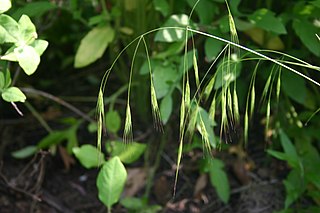
Narthecium is a Eurasian and North American genus of herbaceous flowering plants. This genus was traditionally treated as belonging to the family Liliaceae, but the APG II system of 2003 placed it in the family Nartheciaceae.

Hydrocharis is a genus of aquatic plants in the family Hydrocharitaceae described as a genus by Carl Linnaeus in 1753. It is widespread across much of Europe and Asia, plus a few scattered locations in Africa. It is also reportedly naturalized in parts of North America.

Helianthus × laetiflorus, the cheerful sunflower or perennial sunflower, is a plant in the family of Asteraceae. It is widespread in scattered locations across much of Canada from Newfoundland to British Columbia, and the central and eastern United States as far south as Texas and Georgia. This species is also commonly cultivated and may escape cultivation and be found in areas outside of its core range.

Halodule is a genus of plants in the family Cymodoceaceae described as a genus in 1841. It is widespread on tropical and semi-tropical ocean shores of all continents except Europe and Antarctica.

Monoptilon (desertstar) is a small genus of annual plants in the tribe Astereae within the family Asteraceae.

Tithonia is a genus of flowering plants in the tribe Heliantheae within the family Asteraceae.

Schizachne is a genus of Eurasian and North American plants in the grass family. The only accepted species is Schizachne purpurascens, commonly called false melic. Three subspecies are recognized:

Borrichia is a genus of flowering plants in the family Asteraceae. It is named for Danish physician Ole Borch (1628–1690). Members of the genus are commonly known as seaside tansies. They are native to North and South America.

Triantha is a small genus of flowering plants in the family Tofieldiaceae, first described as a genus in 1879. False asphodel is a common name for plants in this genus.

Burmannia biflora, common name northern bluethread, is a plant species native to Cuba, the Bahamas and to the southeastern United States. It has been reported from Puerto Rico, eastern Texas, Louisiana, southwestern Arkansas, southern Mississippi, southern Alabama, Florida, Georgia, South Carolina, North Carolina and southeastern Virginia.

Lophiola is a genus of monocotyledonous flowering plants native to eastern North America. It has variously been placed in the Liliaceae, the Haemodoraceae, the Tecophilaeaceae or the Nartheciaceae.

Allium macropetalum, the desert onion, is a species of wild onion native to the desert regions of southwestern United States and northwestern Mexico. It is known from desert plains and hills in Sonora, Arizona, Utah, Colorado, New Mexico, and Texas, at elevations up to 2500 m.
Prosartes parvifolia is a rare plant species endemic to a small region in the Siskiyou Mountains of the United States. It is known from only 4 counties: 2 in California and 2 in Oregon. The species has been considered by some authorities as part of P. hookeri but others accept Prosartes parvifolia as a separate species.

Limnobium, common names spongeplant and American frogbit, is a group of aquatic plants in the Hydrocharitaceae described as a genus in 1814. It is widespread in freshwater environments in Latin America, the West Indies, and the United States.

Pleea is a small genus of flowering plants described as a genus in 1803. There is only one known species, Pleea tenuifolia, the rush featherling, native to the southeastern United States.

Bradburia pilosa, the soft goldenaster, is a North American species of flowering plants in the family Asteraceae, native to the south-central United States, primarily the southeastern Great Plains and lower Mississippi Valley, in the states of Texas, Oklahoma, Kansas, Missouri, Arkansas, Louisiana, Tennessee, Mississippi, and Alabama. Additional populations are reported farther east but these appear to be introductions. Its habitats include disturbed roadsides and pine-oak-juniper woods.

Erigeron flagellaris is a North American species of flowering plants in the family Asteraceae known by the common names trailing fleabane.

Erigeron pulcherrimus is a North American species of flowering plant in the family Asteraceae known by the common name basin fleabane. The species grows in the western United States in the eastern part of the Intermountain Region west of the Rocky Mountains. It has been found in Wyoming, Colorado, Utah, New Mexico, and Arizona.

Erigeron tenuis is a North American species of flowering plant in the family Asteraceae known by the common name slender-leaf fleabane. It is native to the south-central part of the United States from central Texas to the Florida Panhandle, north as far as Missouri and Kansas.
Polygonum spergulariiforme is a North American species of flowering plants in the buckwheat family known by the common name spurry knotweed or fall knotweed. It grows in western Canada and the western United States.


















